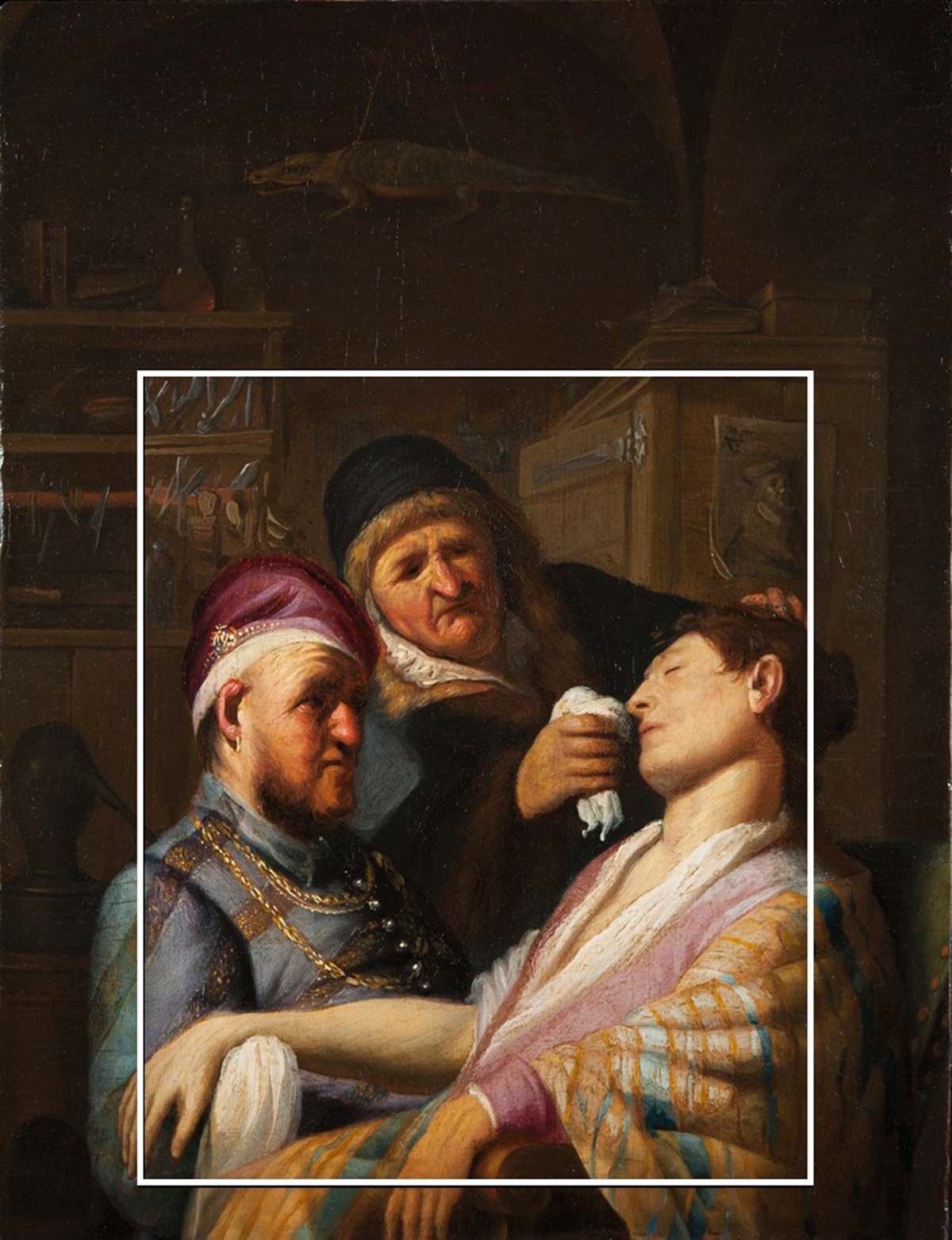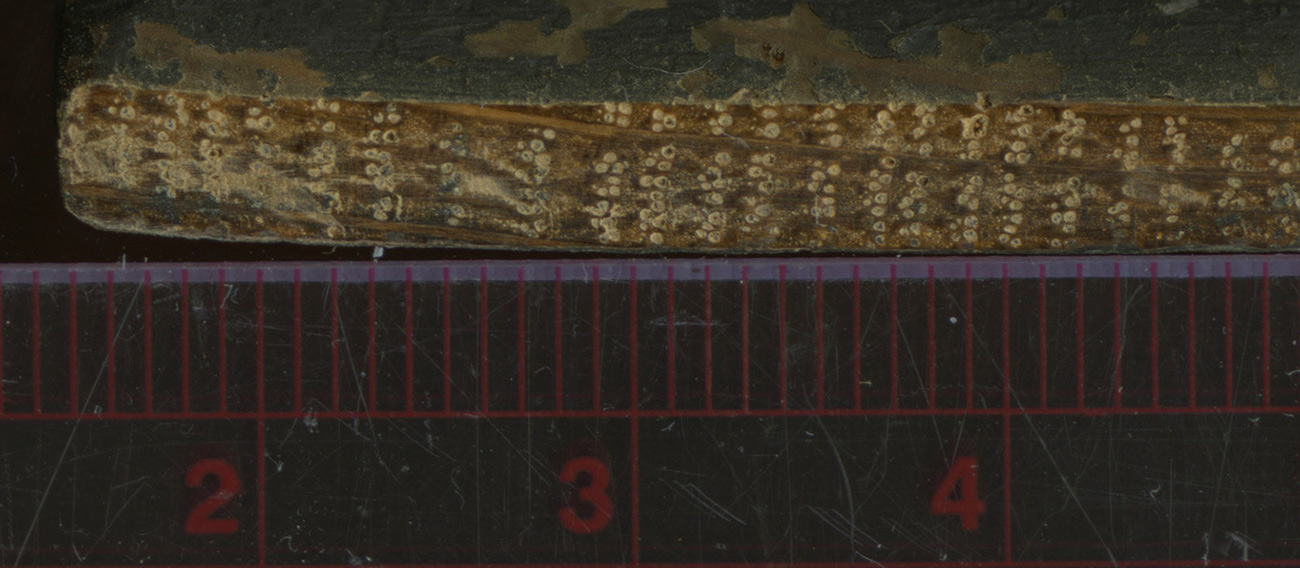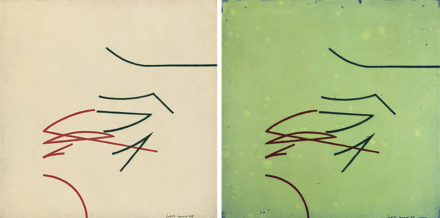Rembrandt’s Senses paintings are the earliest works known by the artist. Dating to about 1624–25, they were made when he was still a teenager. Long thought lost, the painting illustrating The Unconscious Patient (Allegory of the Sense of Smell)—on loan to the Getty Museum from the Leiden Collection in New York—was rediscovered just last fall and firmly attributed to Rembrandt through conservation and close physical study organized by the Leiden Collection.
One of the key features that helped confirm the attribution of Sense of Smell to Rembrandt and link it to the other known works in the Senses series was its remarkable panel configuration. Its highly unusual composite support, which consists of a panel with an asymmetrical cutout into which the original oak board was inlaid, fits precisely with the formats of the other paintings in the Senses series.
The original composition of Sense of Smell is painted on an 8½-by 7-inch oak panel and portrays two elder figures reviving an unconscious young man with a cloth soaked in smelling salts. This central board was inset into a larger panel surround, 12 ½ by 10 inches, lending more space above and around the figures. This inset panel construction is visible from the front, but there is no trace of the inlaid panel from the back, where we see a single, very old European oak panel, beveled on all four sides.

Rembrandt’s Allegory of the Sense of Smell showing the larger panel surround added in the 1700s. Image courtesy of The Leiden Collection, New York. All rights reserved

Back view of Rembrandt’s Sense of Smell showing the construction of the oak panel on which it was painted. Image courtesy of The Leiden Collection, New York. All rights reserved
For a specialist familiar with the other works in the series, the painting’s peculiar panel construction was a clue that it shared a history with them, before the group was separated. The three other existing paintings, Sense of Taste and Sense of Hearing (also in the Leiden Collection) and Sense of Sight (Lakenhal Museum, Leiden), also contained similar panel extensions when they first came to light in the early twentieth century. The additions were removed several decades ago, however, after scientific study determined that they were not from Rembrandt’s time, but instead had been added in the early eighteenth century. The detached panel once belonging to Sense of Hearing has a virtually identical format, indicating that these modifications all happened at the same time.
Tree-ring analysis performed on the edge of Rembrandt’s Sense of Smell determined that it came from the same tree as the other paintings in the series. Thanks to the science of tree-ring dating, called dendrochronology, we can reliably date northern European oak panels. Analysis was carried out in the 1980s and ‘90s by dendrochronologist Peter Klein on the three Senses known at that time. Klein determined that all three panel extensions originate from the same timber and that they probably date from about 1720.
Just before Sense of Smell came to the Getty, we at the Leiden Collection had the painting’s panel edge prepared for tree-ring analysis. Dendrochronologist Ian Tyers is currently in the process of preparing a full report of the results, but he has confirmed that the extension matches the wood of the addition for Sense of Hearing (recently reexamined for comparison) and that both came from the same tree felled in the early eighteenth century.

Edge of the wood panel on Rembrandt’s Sense of Smell. Image courtesy of The Leiden Collection, New York. All rights reserved
We also carried out pigment analysis to compare the use of materials between the original panel and the extension. Art conservation scientist John Twilley determined that Rembrandt’s original work relied heavily upon the natural blue pigment indigo, particularly in the area of the old man’s striped jacket, whereas the blue found in the area of the panel extension consists of the manmade pigment Prussian blue, an invention of the early eighteenth century.

Rembrandt used indigo for the blue on this figure’s striped jacket. Image courtesy of The Leiden Collection, New York. All rights reserved
Why were these panel extensions added a century later, after Rembrandt’s completion? Although it’s difficult to know for sure, it was probably an expression of a change in taste and a new preference for a larger format. In fact, expanding small-scale paintings in this inlaid manner became an increasingly common practice in Rembrandt’s native city, Leiden, beginning in the second half of the seventeenth century. This is particularly intriguing since Leiden artists following Rembrandt, such as Gerrit Dou and Frans van Mieris, specialized in small-scale painting, and many examples of similar panel expansions exist in their works. In the case of Rembrandt’s Senses, the early-eighteenth-century additions must have been part of this trend in favor of giving the tightly composed works more space around the figures.
In Rembrandt’s original panels, the viewer is compelled to focus on the figures and their human expressions. We are drawn into the stories being depicted and invited to contemplate their allegories. The early-eighteenth-century formats, however, add a fascinating dimension to these scenes that complement them in thoughtful ways. In Sense of Hearing, for example, the atmospheric light portrayed in Rembrandt’s composition is enhanced by the addition of a shimmering candle off to the side. While in Sense of Smell the satirical nature of the doctor who looks worriedly at his unconscious patient is enriched by details added later, such as the large neti pot at the far left and the mounted crocodile specimen hanging from the ceiling, both traditional attributes of a quack.

Rembrandt’s Sense of Hearing showing the larger panel surround added in the 1700s. Image courtesy of The Leiden Collection, New York. All rights reserved
The Leiden Collection has left intact the eighteenth-century format of Sense of Smell, both as a record of its own history and a testimony of the object’s journey through time. The painting’s newly designed frame displays Rembrandt’s original composition, while a custom door swivels open to reveal the eighteenth-century painted additions. Rembrandt’s Senses are an important group of paintings not only because they help us understand the artist’s initial development, but because they reveal the productive exchange between art history and science.

Rembrandt’s Sense of Smell is held in a newly designed frame with a door that opens to reveal the eighteenth-century painted additions. Artwork courtesy of The Leiden Collection, New York. Photo © J. Paul Getty Trust. All rights reserved
Text of this post © Dominique Surh. All rights reserved





In your other discussion of these paintings, you identify each medicinal practitioner as a quack. Was that Rembrandt’s concept of them?
Is there a record of the last time this painting was seen. What is the history that the last owners have of its origins in their family’s collection.
I saw the sense of taste painting somewhere (I don’t think it was a dream) and marveled at the detail in it. I did not know what it depicted but thought it was a curious subject for a painting. It showed three old men, and one was putting a spoon of something into the mouth of another old man who had a sock type cap on his head. Maybe it will come to me where I saw this.